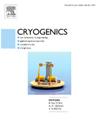基于 3D 模型的热应力下环氧树脂浸渍 REBCO 赛道线圈分层分析
IF 1.8
3区 工程技术
Q3 PHYSICS, APPLIED
引用次数: 0
摘要
由稀土钡铜氧化物(REBCO)涂层导体(CC)制成的超导线圈具有卓越的电磁性能。采用环氧树脂浸渍可以提高超导线圈的结构完整性。然而,当环境温度从室温冷却到 77 K 时,环氧树脂浸渍的 REBCO 线圈会出现分层行为。因此,本研究提出了一种包含内聚区材料(CZM)的三维(3D)力学-热学模型,以研究环氧树脂浸渍的 REBCO 赛道线圈在冷却过程中的分层机制。我们发现,在冷却过程中,线圈的半圆部分比直线部分承受了更大的拉伸径向应力。这导致分层区域往往首先出现在半圆部分,其径向拉伸应力较大。半圆形部分分层区边缘产生的应力集中会导致分层区边缘向直线部分延伸。此外,本文还研究了心轴和过带的热膨胀系数(CTE)对线圈分层行为的影响。研究发现,径向应力、分层初始位置和分层程度都会受到心轴和包带 CTE 的影响。通过降低心轴的 CTE 或增加包边带的 CTE 来降低线圈的径向拉伸应力,可以避免线圈分层。防止半圆部分的分层显然可以避免赛道线圈直线部分出现分层。本文章由计算机程序翻译,如有差异,请以英文原文为准。
Delamination analysis of the epoxy impregnated REBCO racetrack coil under thermal stress based on a 3D model
Superconducting coils made of Rare-Earth-Barium-Copper-Oxide (REBCO) coated conductor (CC) exhibit superior electromagnetic performance. Employing epoxy impregnation can improve the structural integrity of the superconducting coils. However, the delamination behavior is observed in the epoxy impregnated REBCO coil when the environment temperature cool from the room temperature to 77 K. In previous studies, there is a few researches on the delamination and mechanical behavior of the epoxy impregnated racetrack coil. Therefore, this study proposes a three-dimensional (3D) mechanical-thermal model which incorporates the cohesive zone material (CZM) to investigate the delamination mechanisms in epoxy impregnated REBCO racetrack coils during cooling. We found that the coil experienced a higher tensile radial stress at the semicircular part than the straight part during the cooling process. This leads to that the delamination area tends to appear initially in the semicircular part with large tensile radial stress. And the stress concentration generated at the edge of the delamination area in the semicircular part can cause the extension of the edge of the delamination area to the straight part. In addition, the influences of the thermal expansion coefficient (CTE) of the mandrel and overband on the coil delamination behavior are studied in this paper. It is found that the radial stress, the initial position of the delamination, and the degree of delamination are affected by the CTE of the mandrel and overband. And the delamination of the coil can be avoided by reducing the tensile radial stress of the coil through reducing the CTE of the mandrel or increasing the CTE of the overband. And the prevention of the delamination in the semicircular part can obviously avoid the occurrence of the delamination in the straight part of the racetrack coil.
求助全文
通过发布文献求助,成功后即可免费获取论文全文。
去求助
来源期刊

Cryogenics
物理-热力学
CiteScore
3.80
自引率
9.50%
发文量
0
审稿时长
2.1 months
期刊介绍:
Cryogenics is the world''s leading journal focusing on all aspects of cryoengineering and cryogenics. Papers published in Cryogenics cover a wide variety of subjects in low temperature engineering and research. Among the areas covered are:
- Applications of superconductivity: magnets, electronics, devices
- Superconductors and their properties
- Properties of materials: metals, alloys, composites, polymers, insulations
- New applications of cryogenic technology to processes, devices, machinery
- Refrigeration and liquefaction technology
- Thermodynamics
- Fluid properties and fluid mechanics
- Heat transfer
- Thermometry and measurement science
- Cryogenics in medicine
- Cryoelectronics
 求助内容:
求助内容: 应助结果提醒方式:
应助结果提醒方式:


